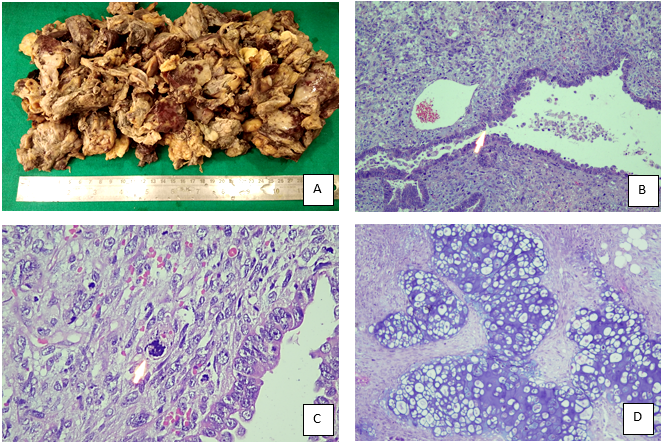- Visibility 41 Views
- Downloads 10 Downloads
- DOI 10.18231/j.jdpo.2021.015
-
CrossMark
- Citation
Malignant mixed mullerian tumor of the ovary: A rare entity
- Author Details:
-
Mehak Kashyap
-
Savreetpal Singh
-
Neelam Gupta *
-
Rashi Garg
Introduction
Malignant Mixed Mullerian Tumors are rare tumors typically occuring in postmenopausal women. They are also known as carcinosarcomas, sarcomatoid carcinomas or malignant mixed mesodermal tumors. They occur throughout the female genital tract, uterus being the most common site. Ovarian MMMTs represent < 2% of ovarian malignancies.[1]
Histologically, MMMTs are mixed neoplasms comprising of both carcinomatous and sarcomatous (mesenchymal) components, which may be either homologous (tissues native to the ovary) or heterologous (tissues that are not found in the ovary normally).[2]
Case Report
A 72 year old post-menopausal female presented to gynaecology OPD with the complaint of pain abdomen (left lower quadrant) and decreased appetite for 4-5 days. She also had a history of mass in abdomen since 7 years. A left ovarian tumor was suspected clinically.
Routine hematological and biochemical parameters were normal.
Serum CA125 level was 139.3 U/ml.
USG revealed a large, lobulated heterogeneously hyperechoic lesion of size 19x10 cm with cystic areas within it in the left lower abdomen in pelvis. Impession was given as left ovarian cyst. MRI revealed multilobulated heterogeneously enhancing abdomino-pelvic predominantly solid mass with extensions 19.5x18.2x9.6cm in cul de sac. Impression of solid cystadenocarcinoma was made. Exploratory laparotomy followed by suboptimal debulking surgery with Total Abdominal Hysterectomy with Bilateral Salpingo-Oopherectomy was performed.
A specimen of uterus with cervix with bilateral fallopian tubes measuring 7x3x2 cm was received. On cut opening, endometrium showed a polyp measuring 4x1.5x2 cm in the fundus of uterus. Cervix measured 3 cm. Bilateral fallopian tubes were unremarkable. Right ovary measured 3x2.5x1cm. Left ovarian mass measured 30x15x7 cm and weighed 1100 g. Grossly, the tumor was greyish white in colour, friable, necrotic and variegated in appearance.
The histopathologic examination of the left ovarian mass showed a biphasic pattern comprising of epithelial and mesenchymal components.
Epithelial component was present in the form of sheets and glands. Tumor cells were markedly pleomorphic with focal hobnailing and clear cell change. Hyaline globules and psammoma bodies were also noted.
Mesenchymal component comprised of spindle cells with marked nuclear pleomorphism. Binucleated and multinucleated tumor giant cells were also noted. There was widespread myxoid degeneration along with focal chondrosarcomatous component.
In addition, there were extensive areas of necrosis and hemorrhage. Mitotic activity was brisk and bizarre mitotic figures were also noted.
Right ovary was unremarkable. Right fallopian tube showed surface tumor deposits. Endometrium showed benign endometrial polyp. Myometrium showed intramural leiomyoma and adenomyosis. Cervix showed features of chronic non-specific cervicitis. Uterus and cervix were free of tumor.
Final diagnosis of MMMT was made

Discussion
MMMT is an aggressive tumor made up of both epithelial elements and stromal component. It is found in the female genital tract mainly in the uterus, and can rarely be found in the ovaries.[2]
Thus MMMT of the ovary is a relatively rare tumor affecting mainly the postmenopausal women. These are highly aggressive tumors and have a poor prognosis.[2]
Many theories have been proposed regarding the histogenesis of these tumors. Collision theory says that carcinoma and sarcoma are two independent tumors. Combination theory suggests that both components are obtained from single stem cells which undergo divergent differentiation. Conversion theory implies that sarcoma is derived from the carcinoma during the evolution of tumors. Another theory suggests that the spindle cell component is just a pseudosarcomatous stromal reaction to an invasive carcinoma.[3] Combination and conversion theories are the chief modes of histogenesis among these theories.[4]
Histologically, ovarian MMMTs are epithelial tumors that are composed of malignant epithelial (carcinomatous) and sarcomatous component. They can be subclassified as heterologous or homologous depending on the origin of their mesenchymal tissue.[5] If the sarcomatous part has elements which are native to the ovary or resemble the mullerian duct system (e.g leiomyosarcoma, fibrosarcoma, endometrial stromal sarcoma), it is called homologous. If the tumor contains elements that are not normally found in the ovary (e.g bone, cartilage, skeletal muscle differentiation, etc.), it is termed heterologous.[3]
The treatment regimen for MMMT is not well established because of the rarity of the disease. It is generally directed against the carcinomatous component instead of the sarcomatous component.[4] Different chemotherapy regimens are used. The role of therapeutic radiotherapy is not established.[1] The overall median survival is 8.2–8.7 months.[5]
To summarize, carcinosarcomas or malignant mixed mullerian tumors of the ovary are very aggressive neoplasms that are usually found at an old age. They are usually advanced at the time of diagnosis and carry a poor prognosis. Poor prognosis associated with this disease emphasizes the need for studies aimed to better understand the molecular changes of this disease and the need to design new therapeutic regimens to improve the survival of these patients.[2]
Source of Funding
No financial support was received for the work within this manuscript.
Conflict of Interest
The authors declare that they have no conflict of interest.
References
- M A Harris, L M Delap, P S Sengupta, P M Wilkinson, R S Welch, R Swindell. Carcinosarcoma of the ovary. Br J Cancer 2003. [Google Scholar] [Crossref]
- R Belbaraka, A Taleb, H Errihani. A rare tumor of the ovary: Carcinosarcoma. J Med Cases 2010. [Google Scholar]
- C. M. Gore, A. M. Hussain, H. S. Yoon, B. M. Blackburn, E. D. Wachsman. Mechanical and Electrical Properties of Ceramic Electrodes for Solid Oxide Fuel Cells. J Obstet Gynecol India 2014. [Google Scholar] [Crossref]
- W G McCluggage. Malignant biphasic uterine tumours: carcinosarcomas or metaplastic carcinomas?. J Clin Pathol 2002. [Google Scholar] [Crossref]
- E Brown, M Stewart, T Rye. Carcinosarcoma of the ovary: 19 years of prospective data from a single center. Cancer 2004. [Google Scholar]
